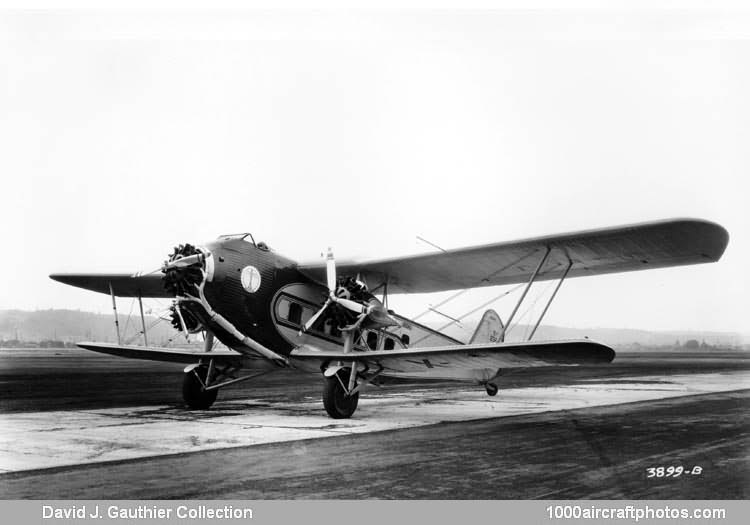02/28/2014. Remarks by Johan Visschedijk: "The success of the passenger-carrying phase of the San Francisco-Chicago route of Boeing Air Transport indicated the desirability of using aeroplanes specifically designed for the purpose, so a twelve-passenger tri-motor transport was designed early in 1928 and first flown in August 1928. With the engines (three 410 hp Pratt & Whitney Wasps) and landing gear installed, the center section was integral with the fuselage and the outer wing panels were removable at the center lines of the nacelles.
Fuselage construction was welded steel tubing in the cabin area, with wire-braced square-section aluminum tubing aft. The wing spars were bolted square duralumin tubing trusses and the ribs were dural tubing and channel similar to the PB-1 flying boat (Model 50). The passenger seats were arranged in four rows, four single seats on the right-hand side of the cabin and four double seats on the left-hand side. A flight stewardess, an innovation to airline service at the time, sat on a jump seat at the rear of the cabin.
The four Model 80s (NC1030 to NC1033, c/n 7135 to 7138) were painted all silver with International orange on the upper surf ace of the top wing. All were later modernized by the addition of engine drag rings and Model 80A vertical tail surfaces in place of the original corrugated metal vertical tail.
The Model 80A was an improved model of the Model 80, the principal differences being the installation of Pratt & Whitney Hornet engines and a redesign of the upper wing to bring the spars closer together so that the front and rear interplane struts were parallel. With the additional power, passenger seating was increased to a total of eighteen. Streamlining was greatly improved over that of the Model 80 by refinement of the nose contours and the addition of NACA cowlings. The cowlings were removed after the aeroplanes entered airline service.
Twelve Model 80A airframes were started, but only ten were completed as Model 80A, the eleventh being converted to Model 226 and the 12th to Model 80B. All Model 80As (NC793K, NC224M to NC232M, c/n 1081 to1090) were later modified to Model 80A-1. The Model 80As were delivered in the new standard Boeing grey color scheme with green fuselage and tail trim and orange on top of the upper wing.
The ten Model 80As were redesignated as Model 80A-1 following a modification program that added tail area in the form of two auxiliary fins and rudders mounted on each side of the main rudder and decreased the fuel capacity because of a higher empty weight. Following withdrawal from airline service when replaced by Boeing 247s, one Model 80A-1 was assigned to the Boeing School of Aeronautics at Oakland, California.
Another (NC224M) was fitted as an electric signboard for night advertising in the Los Angeles area before being sent to Alaska during WW II. This aeroplane was then modified by the installation of a large cargo door on the starboard side of the fuselage, which required the addition of an external truss to carry the tailloads past the cut-out.
The last of the 12 original Model 80A airframes was redesignated following redesign of the nose to accommodate an open cockpit because of pilot resistance to the 'new' closed cockpit of the Model 80. The pilot's and co-pilot's seats were raised to permit backward visibility over the wing. Operated as 80B-1 with 575 hp Pratt & Whitney Hornets, the Model 80B (NX234M c/n 1092) was otherwise identical to the 80As and was converted to an Model 80A-1 (NC234M) by Boeing Air Transport after the pilots were convinced of the advantages of enclosed cockpits."
